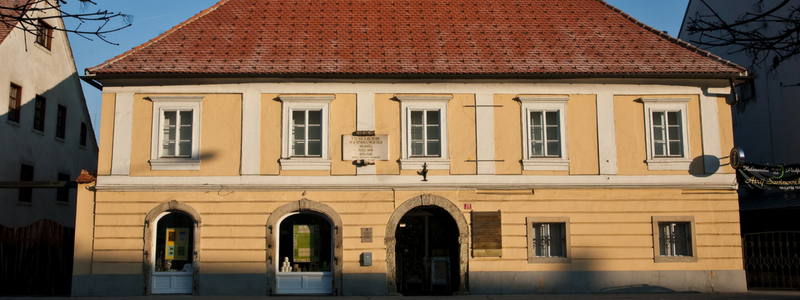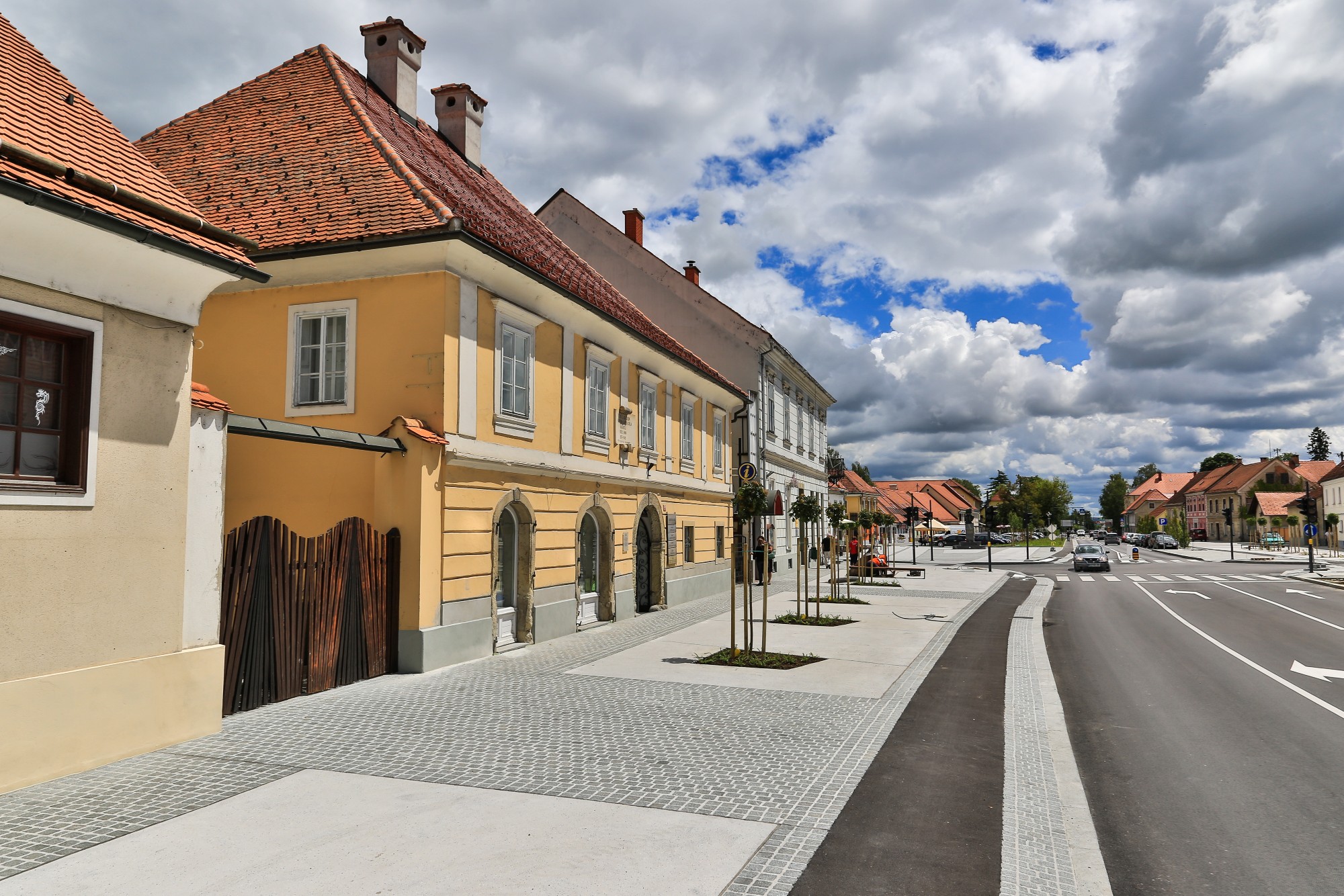Risto Savin’s former home, a representative example of market-town architecture situated in the historic centre of Žalec, is a single-storey building that is listed as a Grade I architectural heritage site for its undamaged facade. It houses a collection of Savin’s material legacy, managed by the Žalec Institute for Culture, Sport and Tourism. Savin’s former study, where he composed his music, was converted into a memorial room; it was opened in 1971 and renovated in 1992. Apart from the memorial room, Savin’s birthplace also houses a gallery of artists from the Savinja region and the Jelica Žuža Salon.
The Risto Savin Memorial Room collection consists of programme notes; diverse correspondence, including an invitation to a reception by the Archduke Carl Ludwig of Austria; the musical score of Abendfriede, a setting of a text by Ludwig Eichrodt; and an elaborately designed porcelain figurine Čajna punčka, which provided the inspiration for the composer’s ballet Čajna punčka, Op. 26 (Tea-doll). The interior is furnished with well-preserved period furniture, a piano and family photographs, a portrait photograph, an oil painting of Savin in military uniform, Savin’s hat (which became his trademark), a Provincial Theatre poster announcing a concert featuring Savin’s works, as well as a variety of military decorations. The composer’s death mask is also on view.
Other items comprising Savin’s musical legacy (scores, manuscripts) are kept in the Music Collection of the National and University Library of Slovenia in Ljubljana. Some movable heritage is housed by the Inter-municipal Central Library, and the Žalec Inter-municipal Library’s Local Studies Department contains Risto Savin’s extensive collection of papers and documents.
Friderik Širca – Risto Savin (1859–1948)
In the late 19th century, when Risto Savin embarked on his composing career, Slovenian composers focused particularly on creating music with a national character. Scant performing practice and limited possibilities of music education in Slovenia tended to hinder many composers from adopting more advanced methods of composition. Whilst unable to fully immerse himself in composing in the military, frequent professional transferrals provided Savin with a relevant insight into the concurrent European music output and allowed him to acquire a deeper knowledge of composition. Savin, whose works, particularly his theatre music pieces, form a pivotal part of Slovenia’s music legacy, is one of the most prominent composers of his generation.
Risto Savin was born as Friderik Širca in 1859 in Žalec. His parents were descendants of respected bourgeois families devoted to the Slovenian national movement. Friderik’s enthusiasm for music developed when he was a teenager. He sang in a choir and took piano lessons and also received tuition in the rudiments of harmony and music theory with a local teacher. In financial straits, his family was unable to fund Savin’s further education. Compelled to end his studies at nineteen, he focused instead on military service. Before reaching his twentieth birthday, he signed up for one year as a volunteer with an infantry artillery regiment in Graz. Later, he rose to the rank of general.
In parallel with his military career, Savin followed the occupation of a composer. As an officer in the Austrian army, he was constantly transferred, and stayed in several cultural hubs. However, Vienna was the city that influenced him most profoundly. He broadened his music horizons by attending the Vienna Court Opera (Wiener Hofoper), and later engaged in a systematic study of composition. When again transferred to Vienna in 1891, he took private tutorials in composition from Robert Fuchs. Increasingly enjoying public attention as a composer and musician throughout this period, Friderik Širca adopted the pseudonym Risto Savin, as an exposed life in music was not befitting for members of the military. After 1897, he studied instrumentation with Karel Knittl in Prague. The end of the war also ended Savin’s double life; as of 1918, the year of his retirement, he could finally devote himself exclusively to composing. He died in 1948 in Zagreb.
Savin applied himself most devotedly and painstakingly to vocal pieces, with four operas as the crowning achievement of his output. The music of his first opera, Poslednja straža (Last Watch, 1904), displays obvious influences of works by Wagner, Richard Strauss and Mahler. It is already this one-act piece that displays the employment of leitmotifs which Savin termed situational motifs. According to musicologist Gregor Pompe, the music of Lepa Vida (Beautiful Vida, 1907), whose leitmotifs constitute the main building blocks of its musical structure, reflects even stronger influences of Wagner and a firmer commitment to music drama. Furthermore, the piece’s distinguishing quality is its daring harmony, with recurrent chromatic alterations and sequences. Another important element of Savin’s operas is the incorporation of Slovenian or Slavic tradition, reflected in, among other things, the choice of libretto materials. He based his first two operas on Slovenian literature, and the other two on historical events. Moreover, the musical structure encompasses Slovenian or South Slavic folkloric motifs. The composer termed his Gosposvetski sen (Maria Saal Dream, 1921), and his last opera, Matija Gubec (1923), national operas.
In his operas, Savin showed great aptitude for tailoring music to dramatic plot situations. While having an undisputed flair for the theatre, he was less fortunate in procuring adequate librettos. An accomplished Slovenian librettist was impossible to find in those days, although Savin invested a great deal of effort to this end. For example, he fruitlessly attempted to enlist Ivan Cankar to write a libretto for Lepa Vida. Consequently, the texts were first written in German, a language in which Savin himself was more proficient. In composing Poslednja straža and Lepa Vida he thus first set to music German texts, and had them subsequently translated into Slovenian. As a result of this process, in certain instances the text fails to fit seamlessly within the music. The librettos for Gosposvetski sen and Matija Gubec were written by Savin, and refined and translated by Fran Roš. The dramaturgy of all his operatic librettos was weak to begin with, occasionally containing contextually unsubstantiated events that dampened the dramatic tension.
Besides theatre music, Savin’s lieder are held in scholarly circles to be his greatest achievement. Initially applying stylistic traits of romanticism, the composer gradually incorporated more daring harmonies into these art songs in his student days. Savin is considered the first composer to have introduced compositional methods of modernism into Slovenian lied. He also wrote choral music for various ensembles, most notably pieces for youth choirs, which blend a functionally devised harmony with dissonances and continued modulations. Orchestral, chamber and piano pieces occupy only a minor role in his output. He also wrote two ballet pieces, Plesne legende (Dance Legends) and Čajna punčka (Tea-doll).
The efficiency with which Savin navigated the course of his double, military and composing, life, also translated into the conceptual duality reflected in his work: the stylistic traits of modernism and folklore-inflected music material. It was this duality of elements that paved the way to an extremely favourable reception from the local community. Slovenian composing circles recognised the value of Savin’s substantial musical structure, a fabric additionally integrated with modernist compositional methods. Gojmir Krek was of the opinion that “each of Savin’s compositions constitutes progress in our music practice”. Moreover, in composing nationally-flavoured works, Savin fostered Slovenian national culture, an advocacy that was at the heart of all artistic fields in that day. Given that his creativity braved the difficult domestic situation, Savin’s output was all the more appreciated. This was because he was one of the few Slovenian composers at the time who dared venture into the theatre-music domain, seeking to create a Slovenian national opera. Moreover, he was one of the first composers to adopt foreign innovations in music composition, thereby substantially enhancing the development of Slovenian late romantic music.
Vesna Venišnik Peternelj


